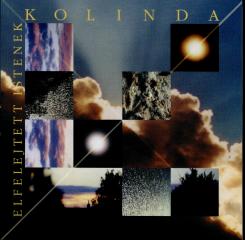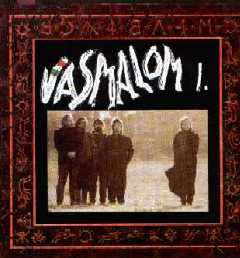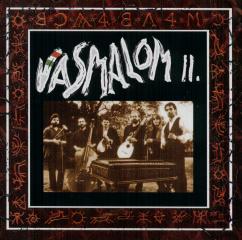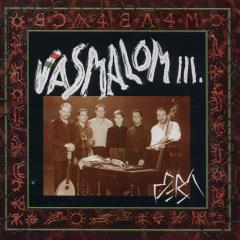
Kolinda were formed in 1975, the name finds its roots in the Christmas and New Year’s songs about the Betlehem playing. Kolinda represents the folk music of Eastern Europa with amazing richness. Their music contains a mix of classical and jazz influences. Nowadays Kolinda play Real World music with a stunning balance between instrumental, vocal, acoustic and keyboard sounds. In the new Millennium, Kolinda celebrate their 25th Anniversary with their tenth album “
"They're one of the most interesting European groups that I've heard," says Gary Cristall, organizer of the Vancouver Folkfestival, "but they do it in a different way. Even though they were doing traditional stuff, it had a different edge to it. They've never been looked on very favorably in Hungary. They were always a little too far outside."
Kolinda's reputation for being outside comes from the way they mix elements of Hungarian and Balkan folksongs with a large amount of jazz, a bit of classical, and even a few notes of rock. Their music manages to melt the passion and urgency of gypsy music with the cerebral with of cool jazz, an exciting combination that makes them one of the most successful hybrids of folk and contemporary music around today.
Kolinda first formed in 1975, and in the next four years they released three albums on the French Hexagone label. But in 1978 the group disbanded and the members went on to other projects.
In 1984, the group got together for a reunion tour. They've been playing together ever since, and have recorded four albums. But even with their diverse sources of inspiration , Kolinda never sounds contrived.
While other "ethnofusion" bands often seem like a patchwork of styles and cultures - contemporary instrumentation precariously and arbitrarily tacked on to ethnic folk music - Kolinda always sounds inevitable. They weave all their various influences together so seamlessly that it somehow seems as if it could be no other way. Their sounds is a solid, unified whole that blends fervor and freshness without a hint of artifice.
01. Napforduló
02. Korai leltár
03. Körtánc
04. Nem számít
05. Elfelejtett Istenek
06. Nekünk a legszebbik estét
07. Rohanás 9-ben
08. Ébresztő
09. Hull a levél
10. Újhold
11. Pengetünk
Part.I.
Part.II.

Ancient Hungarian folk songs with contemporary accompaniment - the unique sound of Makám. Makám was formed in 1984 with the purpose of establishing a peculiar form of community playing music, a special synthesis of harmonies, trying to show the common characteristics belonging together in music cultures of different peoples and contrasting musical forms.
This is a sort of chamber music containing the elements of ancient Hungarian folk music, classical and contemporary music as well as jazz and rock. It's melody and rhythm are influenced by the East European, Balkan, African and Oriental music.
We are convinced that the ancient Hungarian Folk Music is in deep relation with Eastern Traditions. So we arrived at the cultures which are, geographically, far from Hungary.
01.Gyöngyvirág
02.Akármerről fújjon
03.Kerek a szőlő
04.Elindultam
05.Édesanyám
06.Fúdd el jó szél
07.Kiszáradt a tóból
08.Tilinkós
09.Estéli imádság
10.Vadászat
Musicians:
Lovász Irén - voice
Bognár Szilvia - voice
Grencsó István - sax, "tilinkó", harp
Thurnay Balázs - kaval, udu, flutes, vocals
Bencze László - double bass, piano
Krulik Eszter - violin
Mizsei Zoltán - sansa, chimes, vocals
Gyulai Csaba - udu, debourka, viola
Krulik Zoltán - guitar, piano, Roland W30
Lengyelfi Miklós - bass
Szőke Szabolcs - gadulka
All the music is composed by Zoltán Krulik, based on traditional Hungarian folk songs
Link
Címkék: Bognár Szilvia, Hungarian, Lovász Irén, Makám, World

"... András Monori shatters the safe but boring musical standards, creating a fresh and strong, playful and humorous new world that also contains an element of intimacy. The instrumentation, which puts Balkan and Hungarian folk music on a Latin base and spices it up with jazz improvisation, reflects Monori's impressive talent, while leaving room for the perfect instrumental skill and creativity of the virtuoso musicians he has hand-picked to work with him. The group's new repertoire is written for two voices, male and female, making the catchy melodies richer and more nuance. It's not surprising that young and old, rebel and conservative, lovers and the unhappy, all identify with this music."
01. Portugál (filmzene)
02. Dilmano
03. Ajdirinda
04. Szeretlek, szeretlek
05. Fehér
06. 4 Török
07. Mamikám
08. Mindegyre
09. Szeretőm e táncba
10. Török bicikli
11. 3 Török
12. Adjon Isten
13. Portugál kalap (filmzene)
Bea Palya - voice
András Monori - kaval, trumpet, gadulka, flute, tambura, kalimba
Béla Ágoston - saxophone, clarinet, flute, bagpipe
Péter Nagy – double bass
Szabolcs Árkosi - accordion, saz
Tamás Kovács – konga, percussion
Gábor Pusztai - percussion, drum
Link
pass: bluesmen-worldmusic.blogspot.com

"Hungarian ensemble Vasmalom formed in the early 80’s, but their debut album didn’t come out until 1989. That first album has just been reissued on Periferic, along with the group’s second and third disks. Although differences exist in lineup, instrumentation, and arrangement among the three CDs, the similarities outweigh the relatively minor differences and these three albums can be thought of as all going together.
The music here can accurately be characterized as ‘Hungarian folk’, but only seven of the twenty-nine tracks on these CDs are based on traditional melodies. Rather, the majority are original compositions written in the style of different types of folksong. This includes frenzied peasant dances (such as “Thi-Dli-Dli-Dli Dli-Dli-Dli-Dliii” and “Ludasim, Pajtásim!”), mournful love songs and laments (à la “Gyere Velem Katonának…” and “Testvér…”), and religious chants (e.g. “Add Fel Isten Azt a Napot…”). Vasmalom also draws upon the musical traditions of Hungary’s Gypsies and other ethnic minorities in tunes like “Bolgár Cigány Horo” and “A Cimbalos Moldávai”. With so many different types of folk traditions being used, there is ample variety for the listener’s ear and things never get too repetitive. Moreover, the band regularly mixes up its instrumental palette, so that even songs of the same type never sound too similar. On one track, fiddles and cimbalom (Hungarian mandolin) may be the lead instruments, while the next may feature the gorgeous voice of singer Éva Molnár backed only by duda (Hungarian bagpipes) or tapan (an exotic sounding Czech flute). There are even a few tunes on which non-folk instruments are featured, such as the soprano sax lines in “Viharsarokk” and the harmonica solo in “Keresztutak”. Although Vasmalom is primarily a folk band, they do not adhere rigidly to traditional forms or stylings. A jazzy groove often colors the double-bass playing of both László Nemessányi (1st album) and Tibor Csuhaj-Barna (2nd and 3rd albums). The flautists (three different ones on the three albums) play with an aggressive, breathy tone reminiscent of Ian Anderson. Similar observations could be made, really, about all of the musicians here— they play their instruments precisely and skillfully, but with a raw energy more typical of rock than of folk. The arrangements, furthermore, leave more room for individual improvisation than is typical in folk music— especially the all-instrumental dance tunes, which often serve as occasions for soloing. Still, with the exception of the experimental eight-minute “Porondos Víz.…” (from the third album), there’s no mistaking that this is folk music— and not folk-rock,prog-folk, or the like. Perhaps the best comparison might be to Hungary’s own Kolinda, although it wouldn’t be too far off the mark to say that Vasmalom does the same sorts of things for Magyar music that Northside bands like Väsen and Groupa do for Swedish folk. Personally, my favorite of the three is the first, but that’s just a matter of taste. If you have any interest at all in Hungarian folk— you really can’t go wrong with any of these. Very highly recommended."

01. Adj Istenem adj erőt a lovamnak (God Give Strength To My Horse)
02. Hej Tok lányok (Hey Girls)
03. Rab vagyok (Prisoner's Song)
04. Kecsketánc (Goats Dance)
05. Búbánat, Búbánat (Sorrow) Együd Árpád Emlékére
06. Tiii-Dli-Dli-Dli Dli-Dli-Dli-Dliii
07. Gyere velem katonának (Come With Me To Be A Soldier)
08. Hol jártál barjánkám? (Where Have You Been My Little Lamb)
09. Jár a kislány (Goes The Girl)
10.Ludasim, pajtásim (My Companions)
ANDRÁS DÓCZY - violin & vocal,
ÉVA MOLNÁR - lead vocal & kontra,
GÁBOR REŐTHY -mandocello, moldavian flute (bass), darbuka, jews harp, tapan, Roland S 50, vocal,
LÁSZLÓ NEMESSÁNYI - double bass & vocal, FERENC TOBAK - bagpipe, flute, long flute, moldavian flute.
Part I.
Part II.

1. Dudanóta (Bagpipe Song)
2. Gergelem (Gergel Dance)
3. Szerelem (Love)
4. Kerekes /Péter Kertje/ (Ring Dance /Peter's Garden/
5. Járd ki lábam (Come On Feet, Dance)
6. Testvér (Brother) Együd Árpád Emlékére
7. Napra Csillag (Stars Follow The Sun)
8. Add fel Isten azt a napot (God Makes The Sun Rise)
9. Keresztutak - Négy Tétel (Crossroads - Four Movements)
KÁLMÁN BALOGH - cimbalom & viola,
TIBOR CSUHAJ-BARNA - double bass & vocals,
ANDRÁS DÓCZY - violin, lute & vocals,
ÉVA MOLNÁR - lead vocals, viola, pecussion bass viola,
GÁBOR REŐTHY - mandocello, tapan, darbuka & vocals,
BALÁZS SZOKOLAY - bagpipe, flutes, soprano sax, tilinkó, mouth harp, mongolian style singing.
Part I.
Part II.

1. Dudanóta II. (Bagpipe Song II.)
2. Veres az ég (The Sun Sets Red)
3. Erdélyes (In Transilvanian Style) Traditional Transilvanian Song
4. Párját vesztett (Lonely Bird)
5. Gergelytánc (Gregory's Dance)
6. Porondos víz (On The Bank Of A Sandy River)
7. A cimbalmos moldvai (The One From Moldva With Cimbalom)
8. Szerelem II. (Love II.)
9. Viharsarokk (Viharsarock)
SZOKOLAY DONGÓ BALÁZS - bagpipes, flute, fujara, soprano sax, mongolian style singing,
BALOGH KÁLMÁN - cimbalom,
NYIRI LÁSZLÓ - violin,
MOLNÁR ÉVA - vocal,
PAPP ÁGNES -vocal,
REŐTHY GÁBOR - mandocello, tapan, tilinko,
CSUHAJ BARNA TIBOR - double bass.
Part I.
Part II.
Palya Bea: Álom-álom, kitalálom
(Dream, Dream, my Invented World)
- Fairy Tale for Children and Adults -
1 Comments

This is a fairy tale told in song: the songs are independent but linked, like the pearls of necklace, together they form a precious piece, a magical lyrical story….
My initial inspiration came from the many children with whom I’ve played a game known as the rose-finding journey over the years.
I was guided further by the symbols of the Hungarian folksongs, folktales and poems, and, above all, by my dreams and the experiences of my own soul; for this piece is not only for children, adult questions are raised as well.
For me, it is not so important that the listener – child or adult – follow the story logically, but rather that they meet the main characters of the tales I sing: Sindbad, Balint Balassi - a Hungarian poet from the 16th century - and Boris Vian.
As they meet them, so they will meet the main questions contained in the songs: Why is it so important to love and to be loved, where is the border-line between dream and reality….
Or, perhaps, as they listen they simply find their imaginations moving through this strange world full of wonderous music and sometimes surprising sounds…
My colleagues Gryllus Samu and Bolya Mátyás and I wish our listeners many long intimate evenings, listening to the music and looking at the paintings. As they do so, so they help us to weave a musical magic carpet across land and sea…."
Opening
01. My uncle Laci
The Garden
02. Morning walk – As much roses as exist
03. The witch
04. My bird, who stole the Rose?
05. Let us hit the road
Dream Castle
06. Castle song
07. French Dance Master (Dance "Toppantós“, "Pontozó“, "Volta“)
08. House of Complaining Women (Virgin’s song, Old girl’s song)
09. Dinner of Great Men
10. Jazzclub (Coctail Piano, Tunnel to Hell)
11. Bagpipe player from Hell
Gypsy Camp
12. Mamo csitté
13. The Man called Imruska
14. "Sing a song for me!“
15. We are the roses
16. The crash of the Witch
17. Blessing
Wedding
18. Husband-to-be, Wife-to-be
19. Ride, my little horse
Dream?
20. Wake up
Collaborate:
Füri Anna, Sebő Ferenc, Fazekas Gergely (Gregoire Potier), Szabó Dániel, Daróczi Ágnes, Szokolay Dongó Balázs, Novák Csaba, Dés András, Fassang László, Nyíri László.
Part 1.
Part 2.

Lajkó Félix was born in Yugoslavia on December 17th in 1974. He started playing the zyther when he was 10 and won all the possible prizes in this category in Yugoslavia and Hungary. He first had a violin in his hand when he was 12, and has finished the six years of musical school in three years time. He has then finished his formal studies and turned towards concerting. Played jazz with Dresch Quartett (H), contemporary music with the Hungarian piano composer and player Szabados György and was a member of the Ensemble Ritual Nova of Boris Kovac. Has performed with Romanian born, London based Alexander Balanescu. Has played in Budapest, Prague, Berlin, Belgrade, Paris, Bordeaux, Frankfurt, Edinbourgh, Tokyo, Bratislava, Venice, Verona, Wuppertal and Monte Carlo, and has twice toured Romania this year. In 2001, Félix has played at the world famous theatre festival of Avignon and the most prestigious Theatre de la Ville in Paris and has had a very warm welcome at the Pina Bausch Festival in Wuppertal.
"My music is based on the delicacy and colourfulness of my instrument. I do not play any new types of musical genre, I only follow my own path and improvise and write music. I cannot see differences between musical styles and ways, so I play folk-, classical-, rock-, blues-, and improvisational music. I have written music to several theatre plays and films for Yugoslavian and Hungarian directors. I wrote a musical piece for the festival commemorating the Sarajevo Cultural Olympics."
Has peformed with Min Tanaka from Japan, Noir Désir (F), Alexander Balanescu (GB) and with Boban Markovic (YU). The famous Hungarian film director Miklós Jancsó has shot a movie about him in 1999. Félix has been awarded the prize of "Young Artist" in Hungary and in the year 2000 has received "Pro Urbe" (For The City) in his home town of Subotica / Szabadka.
01 El cavillo 7'08
02 Single 8'17
03 Zyther player 6'23
04 Long 14'20
05 Etno camp 13'29
06 Serenade 10'52
Lajkó Félix violin, zither
Kurina Ferenc double bass
Varga Károly viola
Kurina Mihály cymbalum, guitar
Takács Tibor drum
Link
Címkék: Hungarian, Lajkó Félix, World

Both performers were born in Voevodina (part of Northern Serbia with large Hungarian population). Tünde has participated in numerous folk bands, including the band of Felix Lajko. Geza was the founder of the dance-house movement in Voevodina. He was prominent member of such important Hungarian folk bands as Vizöntő. This CD contains Moldavian chango songs accompanied mainly on koboz (folk lute). The musicians' aim is to save a very sincery world as it's renewal. Their songs and lute-music speak of a passing world, depicting the Eden of Moldva in virtuosity of ornaments, but simultaneously giving a confession about their own inner selves.
01. Tavaszi szél - Spring Breeze
02. Erdo, erdo - Forest, Forest
03. Madár (Muntenia) - Bird (Muntenia)
04. Tavasz - Spring
05. Menyecske, menyecske - Bride, Bride
06. Ének Szent Lászlóhoz - A Song To St. Ladislas
07. Hol vagy István király? - Where Are You King Stephan?
08. A pünkösdi rózsa - The Peony
09. Túl a vízen - Beyond The Water
10. Szőr szökött a szemembe - A Hair Fell Into My Eye
11. Gyöngyös György unokája - The Grandson Of Gyöngyös György
12. A zsivány felesége - The Outlaw's Wife
13. Katonás - Soldiers's Song
14. Hegyen s földön - On Mountain And Ground
Tünde Ivánovics - voice
Géza Fábri – koboz
Guests:
Members of Zurgó:
Lídia Draskóczy - violin
Bercel Nagy - flute
László Demeter - koboz
Andrea Navratil – voice
Balázs Szokolay Dongó - kaval, Jew’s harph, flute, bagpipe
Dániel Lipták - violin
Link
Címkék: Folk, Hungarian, Ivánovics Tünde - Fábri Géza, World

The inspiration for this encounter between Hungary's Iren Lovasz and the folk-jazz-bluegrass band Teagrass came from Michal Shapiro, a New York-based music producer and journalist. As usual, Shapiro was right. There could be no better companions for a musical exploration of the various ethnic enclaves and nationalities living along the Danube River. Balkan, Gypsy, and Jewish tunes turn up, flanked by several songs of specifically Moravian or Hungarian origin. The acoustic nstrumentals are creative, tight, and clean. Teagrass employ a hurdy-gurdy, viola da gamba, fiddle, clarinets and saxophones, plus flutes and bass, but the mandolinist makes the strongest impression. The group has an eclectic quirkiness that is refined but not inhibited by Lovasz's erudition and cultural integrity, and the ensemble provides an ideal setting for her flawless singing.
01.Nem egyszer
02.Vüstyi, vüstyi
03.Kdyby mne tak bylo
04.Verjen meg az Isten
05.S örözgeti vala
06.Üstyen, Üstyen
07.Szól a kakas már
08.Piros pántlikámat
09.Kedz sa mily
10.Márton Szép Ilona
11.Hegyen, földön
12.Byla cesta
13.Széles az a Duna
Link
Címkék: Czech, Hungarian, Lovász Irén, World

The ensemble was formed by three young sax-players in 1992, all born and, by and large, still living in the Southern and South-Eastern end of the Great Hungarian Plains. In fact they derive their name from the region of their birth. ("Dél-alföldi" means "of the Southern Plains"). Their common ground is not just a matter of geography, although geography matters too because the corner of Hungary they come from practically borders on the Balkans and that is also something that you can hear in their music. The present personnel crystallized in 1997. Their repertoire includes folk arrangements, traditional pieces, and jazzy, almost danceable compositions with their roots in the rhythmic world of Hungarian and Eastern European folk music and jazz. Their musical choices are illustrated by their instruments too: the bag pipe, the hit gardon (a percussion instrument resembling the shape of a cello), traditional recorders, and the "körtemuzsika" (a special Hungarian flute) are in their arsenal just as well as a unique vocal effect called tuva singing. In the singular compositional concepts of the three saxophonists just as in the free parts one can point out highly individual ideas. However, the influence of Mihály Dresch’s and György Szabados’ music on their approach is undeniable.
01. Sirató
02. Fekete Kata
03. Matropolis Shaman
04. Új Tánc
05. Verbunk És Rilladri
06. Fecske (Mesteremnek)
07. Esthajnal (Csiribiri Emlékére)
08. Cool
Ágoston, Béla voice/saxophone/clarinet/saxophone - tenor/saxophone - alto
Benkő, Róbert double bass
Burány, Béla Pöcök saxophone
Geröly, Tamás drums
Szokolay, Dongó Balázs saxophone/recorder/clarinet
Link
Címkék: Dél-alföldi Szaxofonegyüttes, Hungarian, World
























